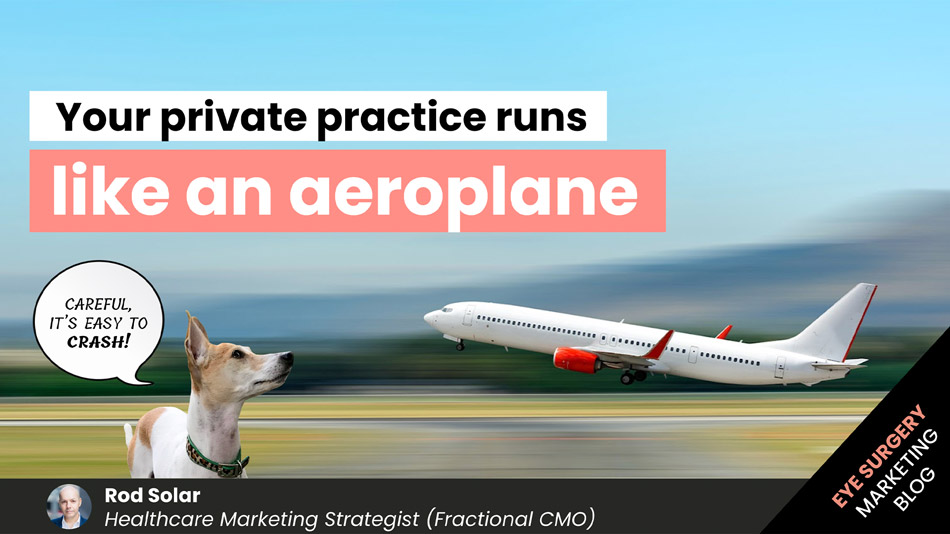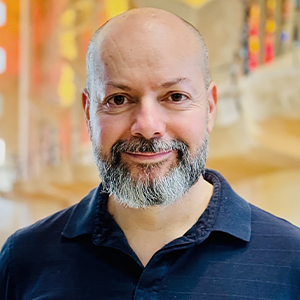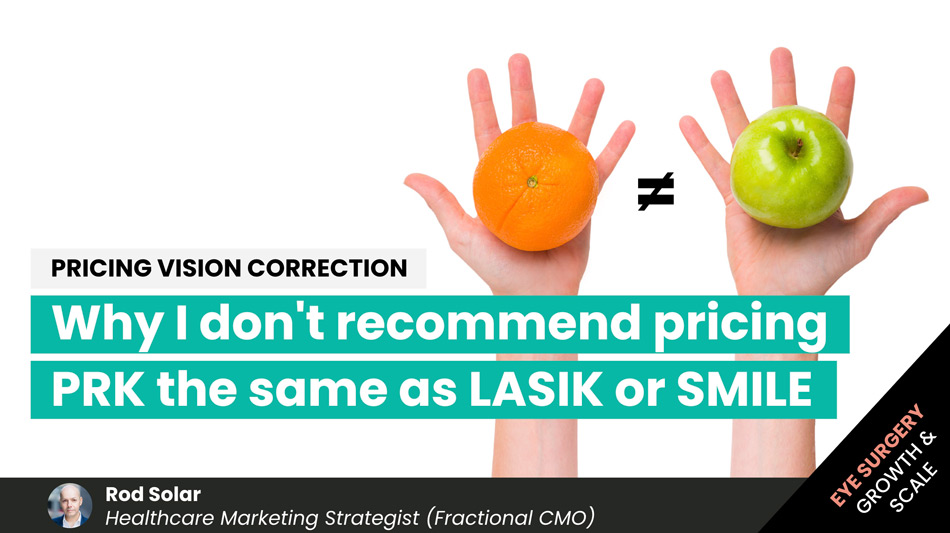
Your private practice runs like an aeroplane
In his “Business Made Simple” course, Donald Miller recommends using a visual metaphor to understand your business. He says that when you have a picture of a healthy business, you can compare that standard to your own. That metaphor will help you build yours the right way.
Without a visual image of what your business should look like, you’re flying blind
What are you supposed to be building? What should it look like, and how should it operate?
As I took Miller’s course, I realised that you, too, might benefit from this terrific metaphor for how any medical practice works.
Miller believes that every business should operate like an aeroplane.
Like an aeroplane, a practice either soars, or it crashes. It needs a leader or a leadership team that knows where it’s going and takes responsibility for getting to where it’s going safely.
Like the body of an aeroplane, a practice needs to be light and lean so that it doesn’t eat up too much fuel getting there.
A plane needs engines to provide thrust to stay in the air, just like a practice needs thrust to make and maintain profit as it attempts to move into and perhaps even dominate a market.
An aeroplane also needs fuel, just like a practice needs cash.
A medical practice really does work like an aeroplane

An aeroplane can get complicated, especially when they get large. But as big as an aeroplane gets, the essential parts of the aircraft are the same.
There is the cockpit, where the leadership sits and flies the plane.
There are the wings, which give the aeroplane lift.
There are two engines. In many aeroplanes, there is an engine on the right and on the left sides that give the aeroplane thrust.
There is the body of the aeroplane, the largest and heaviest part, and that’s where you safely keep the people and the cargo to take them to their destination.
And finally, there are the fuel tanks, which bring the aeroplane to life.
The aeroplane metaphor can help you engineer your company to stay safe, fly far, and be lean and efficient.
So what are the six parts of your medical practice?
Some people would say that every business is different; that’s true. But every successful business has these six parts.
First, you have the cockpit of the aeroplane. That is where the leader or the leadership team sits. If it’s a small plane, one or two people may be in the cockpit. A large plane has three or four people and maybe even two different crews that take turns flying the aeroplane. Nevertheless, the leadership team is responsible for
- making sure the plane is safe
- flying the aircraft to a specific location
- avoiding dangerous air
- And making sure the aircraft does not run out of gas
You and your leadership team are responsible for ensuring that the machine is working correctly. The machine shouldn’t be too heavy. Everyone needs to follow a flight plan that you’ve created so that everyone on board knows where the practice is going. You need to know that you have enough cash or are making enough money to get there.
Second, the wings represent your services. Your services create the lift necessary for the company to rise and fly. Without services to sell, you can’t start or grow a clinic.
- But what kinds of services are best?
- What services should you create?
- What services should you retire?
- How can you test whether or not you should create a specific service?
Miller gives the answers in his course (see below).
Third, is the right engine of the plane which is marketing. Services aren’t enough to get the practice off the ground.
Many practices fail to thrive because they thought people would flock to their website or office and give them money if they had a great product or service.
That is a lie only fools believe.
The truth is you have to market those services. Once the engine produces thrust, it moves those services forward, allowing the wings to create lift. That is where you must clarify your message and execute a marketing plan that works.
Many smaller aeroplanes can indeed fly with only one engine.
Fact: I’ve never seen a medical practice become a multi-million dollar/euro/pound company without a single sales representative.
Fourth, is the left engine of the plane which is sales. Some leaders focus on the right engine (i.e. marketing), but once they hire a salesperson and then create an organised and effective sales team, the plane begins to cut through the air.
The principles of managing a sales team and managing relationships with customers and potential customers are all the same. However, to run an effective sales team, you have to have a pipeline to customise communication with each customer. And also, a sales system that invites customers into a story that features the customer as the hero.
The fifth part in the analogy is overhead. That is the body of the aeroplane. When most people are trying to turn around a company, they start with overhead. It makes sense.
But when Miller advises companies, he likes to start with a vision, then get into the right and left engine to increase sales. He wants cash coming into the company even before suggesting trimming overhead.
A company that is going down needs cash, and it needs it fast. So, you get cash from your marketing engine and sales engine. Then, and only then, does he suggest looking at overhead (the aeroplane’s body).
A plane needs to be lean. If the aeroplane’s body is too large or too heavy, the aircraft will not fly, or worse, fly a little while and then crash. Overhead increases when people spend money.
Overhead decreases when people invest money and get a return. In other words, you want to transfer a lot of the money you’re spending on overhead and get it out into the wings, into the right and left engine so that you get a better return.
You need to make a business case for every dollar, euro, or pound you spend. That’s the key to decreasing overhead. Make sure that the money you spend is an investment that’s getting a return.
If you’re spending money on the company and getting a return on that money, it doesn’t count as overhead. It’s either service delivery, your marketing or your sales. That’s how you make a lean company.
Don’t just cut 15% of all spending. Cut bad operational investments. You need to know what is and isn’t a sound operational investment.
Finally, the sixth part of the plane are the fuel tanks, or cash flow, which is the most important priority when running any business.
How do you manage the money, so you don’t run out? First, you need to arrange your finances to have a crystal clear view of where your practice is financially.
Once you understand how a business works and the fundamental rules you must follow to keep it in the air, running your practice will turn from terrifying to hopefully enjoyable and safe.
In his course, Miller provides checklists. He asserts that flying schools train pilots using checklists. A good pilot does not trust their gut; they trust their training.
If you’ve ever taken a flying lesson, you know that there is a pre-flight checklist, a take-off checklist, a flight navigation checklist, a landing checklist and even a maintenance checklist.
Over the decades since we took to the air, pilots and engineers have passed down knowledge to ensure flying was safe.
It would be best to have a protocol for building a practice that works. Every practice leader needs to understand how to create a machine that soars through the air safely, well, and profitably.
Private practice is a machine that makes money.
It has six parts. It’s easy to crash. It’s also easy to get right if you build it the right way. If you’re interested in taking the course that provides checklists for each of these business functions (and much more), you can do so at Donald Miller’s Business Made Simple website.
(NOTE: Want to see how your practice marketing measures up against the best in class? Take this 5-minute quiz to see how you stack up in the 9 areas of practice marketing and get specific tips and advice on how you can improve your weak points and better leverage your strengths).
About the author

Rod Solar
Founder & Scalable Business Advisor / fCMO
Rod Solar is a co-founder of LiveseySolar and a Scalable Business Advisor for its customers. Rod mentors and coaches eye surgery business CEOs/Founders and their leadership teams to triple their sales, double their profit, and achieve their “ideal exit”.
Related Posts
Meet our Co-Founders
We’re passionate about helping leaders of high-quality, growth-minded practice owners double their practice revenue

Rod Solar
Founder & Scalable Business Advisor
For over 20 years, I’ve helped ophthalmology entrepreneurs scale their private practices. I specialise in doubling revenue within three years by offering a proven framework, hands-on experience, and a team of experts who implement what works. We take the guesswork out of growth and scale, so you can focus on delivering exceptional patient care while maximising the value of your business.
LiveseySolar completely transformed the way we were approaching this… We’ve gone from having just the dream of having a practice to having a practice up and running with people making inquiries and booking for procedures… It’s extremely pleasing. We feel lucky we connected with LiveseySolar.
— Dr Matthew Russell, MBChB, FRANZCO, specialist ophthalmic surgeon and founder of VSON and OKKO

Laura Livesey
Founder & CEO
I’m the co-founder & CEO of LiveseySolar. I’ve developed powerful eye surgery marketing systems that increase patient volumes and profits for doctors, clinics, and hospitals, since 1997.
Rod and Laura know as much about marketing surgery to patients as I know about performing it. They are an expert in the field of laser eye surgery marketing. They know this industry inside out. I believe that they could help many companies in a variety of areas including marketing materials, sales training and marketing support for doctors.
— Prof. Dan Reinstein, MD MA FRSC DABO, founder of the London Vision Clinic, UK











